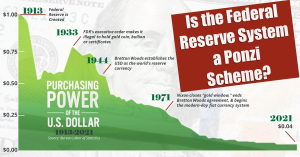Updated – December 28, 2022
The S&P Challenge and Fortune 1000 Challenge Numbers are from the reporting period ending September 29, 2022, which are updated from the original section’s reporting period of March 30, 2022, listed below
S&P 500 Challenge Update
Number of S&P 500 Companies Appearing in the Top 10 of Institutional Holdings
Vanguard: 500
Blackrock: 500
State Street: 500
Total Value of Holdings Across all S&P 500 Companys’ Top 10 Institutional Holdings
Vanguard: $2.980 Trillion
Blackrock: $2.425 Trillion
State Street: $ 1.487 Trillion
Total Market Capitalization of all S&P 500 Companies is $33.445 Trillion
Calculated Percent Ownership Across S&P 500 Companies
Vanguard: 8.91%
Blackrock: 7.25%
State Street: 4.45%
Total Precent Ownership of all 3= 20.61%
The S&P Challenge Update represents the institutional holdings of Vanguard, Blackrock and State Street in companies that are listed in the S&P 500 from the reporting period ending September 29, 2022.
Fortune 1000 Challenge Update
Number of Fortune 1000 Companies Appearing in the Top 10 of Institutional Holdings
Vanguard: 981
Blackrock: 975
State Street: 895
Total Value of Holdings Across all Fortune 1000 Companys’ Top 10 Institutional Holdings
Vanguard: $ 3.233 Trillion
Blackrock: $ 2.657 Trillion
State Street: $ 1.565 Trillion
Total Market Capitalization of all Fortune 1000 companies is $36 Trillion
Calculated Percent Ownership Across Fortune 1000 Companies
Vanguard: 8.84%
Blackrock: 7.31%
State Street: 4.36%
Total Precent Ownership of all 3= 20.51%
Comparing Vanguard’s and Blackrock’s value of holdings as of September 29, 2022, in Fortune 1000 companies of $3.233 trillion and $2.657 trillion respectively to Apple’s market capitalization of $2.265 trillion from Octoberf17, 2022, show that their holdings exceed that of the companies with the largest market capitalization.
Original Post – July 7, 2022
In a YouTube video labeled “Who owns big business: the rise of passive investors”, the shift away from actively managed funds to passively managed funds is addressed. This shift was concluded based on a research project conducted by the University of Amsterdam.
Their research points to the financial crises of 2008. After this time, passively managed funds grew substantially, and actively managed funds decreased. A passively managed fund is like an index fund based on basket of stocks such as the S&P 500. An actively managed fund is one that is overseen by a fund manager who decides what stocks make up the fund.
Also, according to their research, three fund management firms, Blackrock, Vanguard, and State Street, represent 40% of the shareholders of all listed firms and 88% of the S&P 500 index. In addition, they are now the dominant shareholder in 88% of the firms listed on the S&P 500.
Isaiah McCall from Medium.com states in his blog post,
BlackRock’s absurd liquidity means that if you look at just about every major publicly traded company in the world you’ll find that BlackRock is its first, second or third-largest shareholder. Go ahead, try it.
The S&P 500 Challenge
So, I decided to take him up on his challenge and conduct some research on my own.
The research steps involved in my research included finding the top institutional investors in each S&P 500 company. The S&P 500 company list was obtained from SlickCharts.com. Since each one of these companies is publicly traded, their institutional holdings are available from various online sources such as Nasdaq.com, Yahoo Finance, Google Finance, Business Insider, MarketBeat, MarketWatch, and various stockbroker websites. CompaniesMarketCap.com is good website to compare market capitalizations.
Some sites provided the top 15 institutional holdings for each publicly traded company and others only provided the top 10. Data collected overtime was used to determine the top 10 institutional investors in each S&P Company. The reporting period for this research used was March 30, 2022. The share price, number of shares, market cap also used this date.
The summary of the data collected revealed the following from 504 stocks. Some companies have more than one class of stock, which accounts for more than 500 stocks.
Number of S&P 500 Companies Appearing in the Top 10 of Institutional Holdings
Vanguard: 503
Blackrock: 503
State Street: 502
Total Value of Holdings Across all S&P 500 Companys’ Top 10 Institutional Holdings
Vanguard: $3.365 Trillion
Blackrock: $2.795 Trillion
State Street: $ 1.727 Trillion
Total Market Capitalization of all S&P 500 companies is $39.1 Trillion
Calculated Percent Ownership Across S&P 500 Companies
Vanguard: 8.60%
Blackrock: 7.14%
State Street: 4.42%
Total Precent Ownership of all 3= 20.16%
The above represents the institutional holdings of Vanguard, Blackrock and State Street in companies that are listed in the S&P 500.
The Fortune 1000 Challenge
The same analysis was also done on companies that are listed in Fortune 1000 list. The list of companies in the Fortune 1000 list was obtained from a free download at Databahn.com. Not all Companies listed the Fortune 1000 are S&P 500 companies. There are 61 S&P500 companies that were not listed as a Fortune 1000 company.
Using the same criteria of the S&P500 analysis of the Top 10 Institutions as of March 30, 2022, the following summary was calculated for Fortune 1000 companies.
Number of Fortune 1000 Companies Appearing in the Top 10 of Institutional Holdings
Vanguard: 995
Blackrock: 987
State Street: 908
Total Value of Holdings Across all Fortune 1000 Companys’ Top 10 Institutional Holdings
Vanguard: $ 3.688 Trillion
Blackrock: $ 3.093 Trillion
State Street: $ 1.832 Trillion
Total Market Capitalization of all Fortune 1000 companies is $43 Trillion
Calculated Percent Ownership Across Fortune 1000 Companies
Vanguard: 8.50%
Blackrock: 7.19%
State Street: 4.32%
Total Precent Ownership of all 3= 20.01%
Comparing Vanguard’s and Blackrock’s value of holdings as of March 30, 2022, in Fortune 1000 companies of $3.688 trillion and $3.093 trillion respectively to Apple’s market capitalization of $2.825 trillion also in March 2022, show that their holdings exceed that of the companies with the largest market capitalization.
Challenge Conclusion Question
So, in taking the challenge, I found out that Vanguard, Blackrock, and State Street collectively own 20% of America’s corporations in either the S&P 500 or Fortune 1000 lists. The obvious question is how did they acquire this amount of equity in America’s publicly held companies?
Question Research
To answer this question, I then checked out each company’s 10-K fillings with the US Securities and Exchange Commission. Blackrock’s and State Street’s fillings can be found online at the SEC’s EDGAR database. Blackrock’s 10-K was for year ending December 31, 2021. State Street’s 10-K was also for year ending December 31, 2021. These documents show that Blackrock has $10.01 trillion assets under management (AUM) and State Street has $4.14 trillion AUM. Since Vanguard Group is a privately held corporation, a 10-K is not available, but Financial Times reported Vanguard’s AUM to be at $7 trillion.
Investopedia.com provides the definition of AUM as:
The total market value of the investments that a person or entity manages on behalf of clients. Assets under management definitions and formulas vary by company.
All 3 firms derive their revenue from fees collected from their clients. To get an idea of how those fees are formulated, Blackrock’s 10-K provides this definition:
Investment management fees are typically earned as a percentage of AUM. BlackRock also earns performance fees on certain portfolios relative to an agreed-upon benchmark or return hurdle.
Essentially, this quote defines third-party investment management.
Third-Party Investment Management History
At this point, a brief review of the history of third-party investment management should be examined. A good place to start is a report by the World Economic Forum (WEF), stating that prior to 1980 most investments were made directly by each corporation. So, what changed around 1980 to make the shift toward third-party investment management?
Employee Retirement Income Security Act (ERISA)
In 1974 The Employee Retirement Income Security Act (ERISA) was passed. One of the elements of ERISA was that it made it clear that companies could use third party investment management. Hence the rise of third-party investment management by companies like Blackrock, State Street and Vanguard Group. Blackrock was founded in 1988. Vanguard was founded in 1975. While State Street was founded in 1792, it created the Standard & Poor’s Depositary Receipt (SPDR) in 1993. State Street’s SPDR 500 (SPY) Trust exchange-traded fund (ETF) was the first of its kind, and they are now one of the largest ETF providers worldwide. Trading on SPY began January 29, 1993. ETFs are widely used for mutual fund investments by third-party investment companies. The clear demarcation from direct to third-party investment management was the passage of ERISA.
It is interesting to note that while ERISA’s intent was to fix pension problems, one of the solutions was to introduce the allowance of third-party investment firms. The report from the WEF states:
With economic and demographic fundamentals promoting ever faster growth in institutional assets since around 1980, the stage was set for the emergence of the modern asset management industry.
Conspiracy Theory or Fact?
Was setting the stage for the emergence of an asset management industry just coincidental? Or was it a cleverly orchestrated plan to gain control of US and global corporations? Was this pension crisis one that was too good to not pass up? Conspiracy theory or fact?
Pension Plan Problems
As its name implies, ERISA covered retirement plans such as individual account plans like the 401K. Prior to 401Ks, pensions were the main retirement plan for employees. In 1875 American Express became the first company to establish a corporate pension plan for its employees. Over time many other institutions began to offer their employees a pension plan.
The major problem for pensions plans was that many were underfunded and were not able to pay out benefits to employees. It became such a major concern that Congress passed the Welfare and Pensions Plan Disclosure Act (WPPDA) in 1958. The WPPDA required that employers and labor unions provide reports to the U.S. Department of Labor (DOL) about the benefits they offered employees. The WPPDA was enacted as an attempt to reform the nature of pensions. As such in 1962 an amendment was tacked on to the WPPDA which gave the DOL power to interpret and investigate pension plans.
Studebaker Game Changer
Pension reform probably got is biggest boost when in 1963 Studebaker closed one of its plants in South Bend Indiana. Of the 10,600 employees only 3,600 who had reached the retirement age of 60 received their full pension benefits. Three thousand of the remaining employees received no benefits and the rest only received 15% of their benefits.
While the plant closed in 1963, it took over ten years before The Employee Retirement Income Security Act (ERISA) of 1974 was passed. In 1972, NBC aired on September 12, 1972, the documentary Pensions: The Broken Promises, which received a Peabody award. This documentary brought national attention to pension abuses and gained public support from millions of viewers for pension reform. ERISA was seen as the legislation that would prevent another pension debacle like the Studebaker collapse.
Jacob Javits to the Rescue
Jacob Koppel Javits was both a US Representative and Senator from the state of New York and was known as the grandfather of ERISA. Being from New York, he also knew the Rockefellers. Nelson Rockefeller was the 49th governor of New York from 1959 to 1973. Even though he was a republican, he was a liberal progressive. Hence the reason why liberal republicans were labeled “Rockefeller Republicans”. In 1974, one year after his term ended as governor of New York, he was appointed, not elected, as Vice President of the United States. This occurred just after Richard Nixon resigned as President and the then Vice President, Gerald Ford, was sworn in as President. Under the provisions of the 25th amendment, which was adopted in 1967, Gerald Ford was the direct successor to the presidency. President Gerald Ford then nominated Nelson Rockefeller to be his Vice President.
Nelson Rockefeller Connection
David Rockefeller, Nelson Rockefeller’s brother, and Zbigniew Brzezinski co-founded the Trilateral Commission.
From Technocracy News Digest’s website, it headlines:
The Trilateral Commission, founded in 1973 by David Rockefeller and Zbigniew Brzezinski, expertly used crisis management to further their goals of using Technocracy to dominate all resources on earth.
Even though Senator Jacob Javits proposed legislation in 1967 to address funding, reporting, and the disclosure of benefit information pension reform as advised by the JFK presidential committee, it took the aforementioned NBC 1972 television special series to garner public support for pension reform.
What is interesting is the close ties between Nelson Rockefeller and Senator Javits. They were both from New York. As mentioned earlier, Nelson Rockefeller was appointed, but he still had to be confirmed by the Senate by a majority vote. According to GovTrack.us, Nelson Rockefeller received 97% of the vote out of 97 votes cast. Clearly, he did not need Senator Javits’ vote.
Here is what is notable about Senator Javits’ yea vote. His opponent was highly critical of Javits, stating that he should disqualify himself from voting for the confirmation of Rockefeller since Javits had received an $18,000 contribution from Rockefeller and $38,050 from other Rockefeller family members and associates.
While there was such a large confirming vote for Rockefeller, it was the large majority that gave Javits the cover to cast a yea vote even though there was so much controversy surrounding the Rockefellers’ contributions.
Correlation is not Causation
Yes, to tie the dominant ownership of America’s corporation to the pension crisis and the subsequent passage of ERISA is clearly a situation where just because two events are correlated does not mean that one caused the other. However, as I have always told statistic aficionados, that, while correlation is not causation, it is a good place to start an investigation. In this case, let’s start with a Timeline.
Timeline
- 1965/1967: Vance Harke introduces and Jacob Javits sponsors Pension Reform bills
- 1971: World Economic Forum founded
- 1972: Documentary Pensions: The Broken Promises aired
- 1974: Jacob Javits main architect of ERISA
- 1974: Gerald Ford became President with Nelson Rockefeller as Vice President
- 1974: Ford signs ERISA into law
- 1975: Vanguard founded
- 1988: Blackrock founded
- 1993: State Street created SPDRs
- Today: Blackrock, Vanguard, and State Street together have a 20% ownership in American’s S&P 500 and Fortune 1000 companies
Wash, Rinse, Repeat
As with other crisis we have seen in the last 50 years, this crisis takes on the same formula: 1). Take advantage of a problem; 2). Gain public support through the media; 3). Present a solution through passage of legislation. 4). The legislation has secondary consequences not known by the public at large. Thereby, another crisis does not go to waste.
When you go back through the history as just displayed, could today’s domination of Blackrock, Vanguard, and State Street have been orchestrated? I think it at least bears further investigation.






